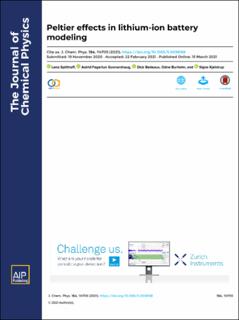Peltier effects in lithium-ion battery modeling
Spitthoff, Lena; Gunnarshaug, Astrid Fagertun; Bedeaux, Dick; Burheim, Odne Stokke; Kjelstrup, Signe
Peer reviewed, Journal article
Published version

Åpne
Permanent lenke
https://hdl.handle.net/11250/2827508Utgivelsesdato
2021Metadata
Vis full innførselSamlinger
- Institutt for energi og prosessteknikk [4200]
- Institutt for kjemi [1391]
- Publikasjoner fra CRIStin - NTNU [38062]
Sammendrag
A high battery temperature has been shown to be critical for lithium-ion batteries in terms of performance, degradation, and safety. Therefore, a precise knowledge of heat sources and sinks in the battery is essential. We have developed a thermal model for lithium-ion batteries, a model that includes terms not included before, namely, Peltier and Dufour heat effects. The model is derived using non-equilibrium thermodynamics for heterogeneous systems, the only theory which is able to describe in a systematic manner the coupling of heat, mass, and charge transport. The idea of this theory is to deal with surfaces as two-dimensional layers. All electrochemical processes in these layers are defined using excess variables, implying, for instance, that the surface has its own temperature. We show how the Peltier and Dufour heats affect a single cell and may produce an internal temperature rise of 8.5 K in a battery stack with 80 modules. The heat fluxes leaving the cell are also functions of these reversible heat effects. Most of the energy that is dissipated as heat occurs in the electrode surfaces and the electrolyte-filled separator. The analysis shows that better knowledge of experimental data on surface resistances, transport coefficients, and Dufour and Peltier heats is essential for further progress in thermal modeling of this important class of systems.